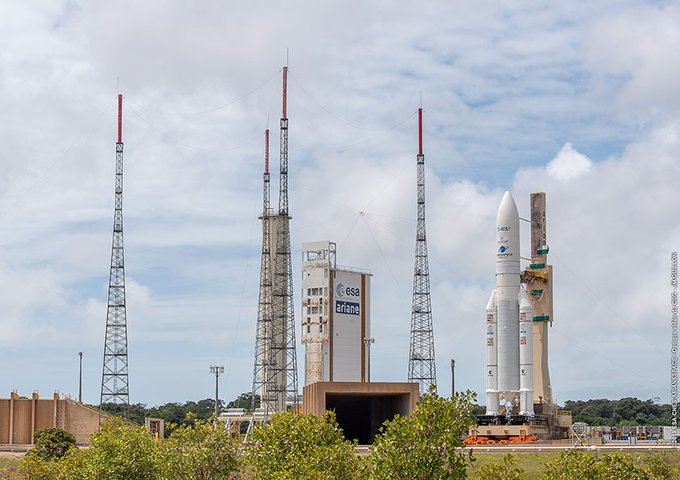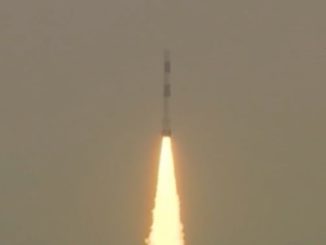
A European-built Ariane 5 rocket rolled out to a launch pad in the South American jungle Wednesday with a pair of commercial television broadcast satellites for AT&T and Eutelsat, setting the stage for liftoff Thursday evening.
The launcher rode to the pad on a mobile platform towed behind a diesel-powered tug Wednesday morning. By midday, the Ariane 5 was positioned atop the launch pad to complete the 1.7-mile (2.9-kilometer) journey from the final assembly building at the European-run spaceport in French Guiana.
Workers planned to make final connections between the Ariane 5 and the launch pad’s propellant, electrical and pneumatic supplies later Wednesday. Teams also planned to fill the rocket’s helium pressurant tank Wednesday in preparation for the start of Thursday’s countdown.
The 179-foot-tall Ariane 5 rocket is scheduled for liftoff from the Guiana Space Center on Thursday at 2143 GMT (5:43 p.m. EDT; 6:43 p.m. French Guiana time). The launch window extends for an hour and 47 minutes.
Thursday’s launch will be the 104th flight of an Ariane 5 rocket, and the second Ariane 5 flight this year. It will be the fifth mission of the year for Arianespace, the French launch services provider that oversees Ariane 5, Soyuz and Vega launch operations at the Guiana Space center.
The two payloads bolted to the top of the Ariane 5 are the T-16 satellite, a broadcasting spacecraft originally ordered by DirecTV before its acquisition by AT&T, and the Eutelsat 7C video relay station, both heading for positions in geostationary orbit more than 22,000 miles (nearly 36,000 kilometers) over the equator.
AT&T’s T-16 satellite, built by Airbus Defense and Space, is the larger of the two payloads on the Ariane 5 rocket. It will ride into orbit in the upper position inside the Ariane 5’s Swiss-built payload fairing, on top of a composite Sylda adapter structure that covers the Eutelsat 7C spacecraft launching in the Ariane 5’s lower berth.

The T-16 spacecraft will join AT&T’s fleet of direct-to-home television broadcasting satellites, which were deployed by DirecTV before its acquisition by AT&T in 2015.
AT&T has released little information about the T-16 satellite or the future of the DirecTV service. In the months after AT&T acquired the satellite broadcast company in 2015, officials said they planned to begin phasing out the DirecTV brand.
Subscribers are also leaving AT&T’s pay-TV services as Internet-based video streaming options become more prevalent in the industry. In the first quarter of 2019, AT&T said it lost 544,000 customers from its DirecTV and AT&T U-verse product lines.
Bloomberg reported earlier this month that AT&T and DISH Network were open to a merger of the longtime competitors in the pay-TV market, which have both suffered subscriber losses in the last year. Citing unnamed sources, Bloomberg said representatives from both companies believe a merger would be approved by U.S. government regulators, although they added there were no active negotiations.
But there are still plenty of customers subscribing to AT&T’s pay-TV offerings. As of the end of March, AT&T’s DirecTV and U-verse services had 22.4 million subscribers.
AT&T’s T-16 satellite is based on the Eurostar 3000 LX spacecraft platform produced by Airbus Defense and Space, which assembled the satellite at its facility in Toulouse, France. According to Arianespace’s press kit for Thursday’s launch, the T-16 spacecraft weighs 13,955 pounds (6,330 kilograms) fully fueled with propellants for in-orbit maneuvers.

Designed for a 15-year lifetime, AT&T’s T-16 satellite carries Ku-band and Ka-band broadcast payloads to reach consumers in the continental United States, Alaska, Hawaii and Puerto Rico.
In a regulatory filing submitted to the Federal Communications Commission last month, AT&T asked regulators for authorization to park the T-16 satellite in geostationary orbit over the equator at 100.85 degrees west longitude, where the spacecraft will orbit the Earth at the same rate as the planet’s rotation.
AT&T said the T-16 satellite will be co-located with the T-4S, T-8 and T-9S broadcasting satellites at the 101 degrees west position. The new spacecraft will take over from the T-15 satellite, which launched in 2015.
Documents submitted to the FCC by AT&T indicate the T-15 satellite was moved last year from a location at 103 degrees west to 101 degrees. The T-15 satellite will leave the 101 degrees west location for another posting in geostationary orbit about a month after T-16 arrives at its operating post, according to the FCC filing.
AT&T did not respond to questions from Spaceflight Now on the T-16 satellite or the future of the company’s satellite broadcast service.
The other satellite launching Thursday is Eutelsat 7C, a spacecraft manufactured by Maxar Technologies — formerly known as SSL — in Palo Alto, California.
The 7,500-pound (3,400-kilogram) satellite is destined for an operating post in geostationary orbit at 7 degrees east longitude. Eutelsat 7C’s coverage zone will include Africa, Europe, the Middle East and Turkey.

Paris-based Eutelsat says the new satellite hosts 49 Ku-band transponders to serve video and data markets. Eutelsat 7C will be co-located with Eutelsat 7B at the 7 degrees east position, and the aging Eutelsat 7A satellite — launched in 2004 — will fly to another location in geostationary orbit, according to Eutelsat.
“By significantly increasing capacity over Sub-Saharan Africa, Eutelsat 7C will have room for several hundred additional digital channels to support the region’s fast expanding TV market,” Eutelsat wrote on its website. “It will also be equipped with a beam providing enhanced capacity for government services over Europe, the Middle East and Central Asia, as well as a steerable beam that can cover any region visible from 7 degrees east.”
Eutelsat 7C is Maxar’s first satellite with an all-electric propulsion system. The low-thrust, high-efficiency plasma thrusters consume less propellant than conventional chemical rocket engines, allowing Eutelsat 7C to carry a lighter fuel load and giving Eutelsat access to a cheaper launch opportunity.
“All-electric satellites provide efficient solutions for satellite operators by reducing launch mass while increasing spacecraft flexility and performance,” said Arlen Kasighian, the satellite mission manager at Eutelsat. “Eutelsat has been a pioneer in all-electric platforms since 2015, collaborating with many major satellite providers.”
A Eutelsat communications satellite launched in 2015 was one of the first two commercial all-electric spacecraft built by Boeing.
The drawback of all-electric propulsion is the longer transit time to geostationary orbit. Instead of taking a few weeks to boost itself into its final operating orbit, Eutelsat 7C’s journey to geostationary orbit will last around four months.
After Thursday’s launch, the Ariane 5 rocket will turn toward the east from French Guiana powered by nearly 3 million pounds of thrust. The launcher will release its two solid rocket boosters less than two-and-a-half minutes after liftoff, followed by the jettison of the Ariane 5’s payload fairing at Plus+3 minutes, 22 seconds.
The Ariane 5’s hydrogen-fueled Vulcain 2 main engine will shut down at Plus+8 minutes, 39 seconds, followed moments later by first stage separation and ignition of the upper stage’s HM7B engine.
The cryogenic upper stage will fire more than 16 minutes to place AT&T’s T-16 satellite and the Eutelsat 7C payload into an elliptical geostationary transfer orbit with a perigee, or low altitude, of 155 miles (250 kilometers), an apogee, or high point, of 22,217 miles (35,756 kilometers), and an inclination of 6 degrees to the equator.
Separation of the T-16 satellite from the Ariane 5 rocket is scheduled for Plus+27 minutes, 43 seconds. The Eutelsat 7C satellite will deploy from the Ariane 5 at Plus+33 minutes, 59 seconds.
Email the author.
Follow Stephen Clark on Twitter: @StephenClark1.



